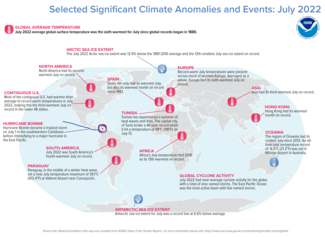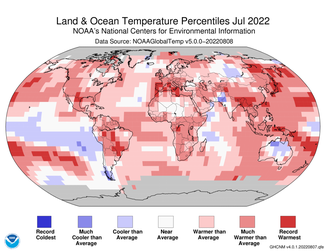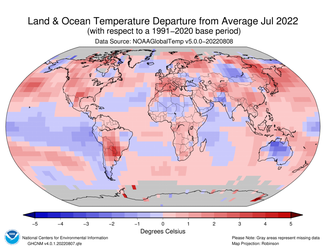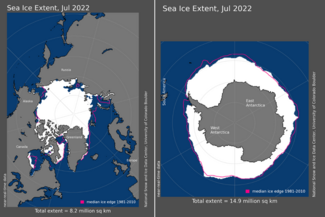Earth had its sixth-warmest July on record

Globally, July 2022 was the sixth-warmest July in the 143-year NOAA record. The year-to-date (January-July) global surface temperature was also the sixth-warmest on record. According to NCEI’s Global Annual Temperature Outlook, there is a greater than 99% chance that 2022 will rank among the 10-warmest years on record but only an 11% chance that it will rank among the top five.
This monthly summary, developed by scientists at NOAA’s National Centers for Environmental Information, is part of the suite of climate services NOAA provides to government, business, academia and the public to support informed decision-making.
Monthly Global Temperature
The July global surface temperature was 1.57°F (0.87°C) above the 20th-century average of 60.4°F (15.8°C). This ranks as the sixth-warmest July in the 143-year record. July 2022 marked the 46th consecutive July and the 451st consecutive month with temperatures, at least nominally, above the 20th-century average. The five warmest Julys on record have all occurred since 2016.
July 2022 was among the top 10 warmest Julys on record for several continents. North America had its second-warmest July on record. Asia had its third-warmest July on record, and its second-warmest year-to-date. South America had its fourth-warmest July, while July 2022 was the sixth-hottest July on record for Europe.
Temperatures were above average throughout most of North America, Europe, and Asia and across parts of northern and southern Africa, China, Japan, central South America, the Arabian Peninsula, and northern Oceania. Parts of Spain, Portugal, Italy, the United Kingdom, Japan, China, northern Africa, and central South America experienced record-warm temperatures for July. Sea surface temperatures were above average across much of the Gulf of Mexico and the northern, western, and southwestern Pacific, as well as parts of the Atlantic and eastern Indian oceans.
Temperatures were near- to cooler-than-average throughout most of Australia and across parts of southern South America, western India, Pakistan, and central Russia. Consistent with La Niña, sea surface temperatures were below average over much of the south-central, central, and eastern tropical Pacific. None of the world's surface had a record-cold temperature in July.
Sea Ice
Globally, July 2022 saw the third-lowest July sea ice extent on record. Only the Julys of 2019 and 2020 had a smaller sea ice extent.
Arctic sea ice extent in July averaged 3.19 million square miles, which is 471,000 square miles — roughly the size of South Africa — below the 1981-2010 average and the 12th-smallest July extent in the 44-year record. Regionally, sea ice extent was well below average in the Barents, Kara, and Greenland seas, the Sea of Okhotsk, and the Hudson Bay. Conditions in Baffin Bay and the Chukchi and Eastern Siberian seas were near-normal or slightly-below average, whereas the Bering and Beaufort seas had above-average extents for July.
Antarctic sea ice extent for July was a record low at 5.75 million square miles, or about 409,000 square miles below average. According to an analysis by the National Snow and Ice Data Center (NSIDC) using data from NOAA and NASA, low ice extent persists in the Weddell and Bellingshausen seas and the eastern Antarctic coast.
Global Tropical Cyclones
July 2022 produced nine named storms across the globe, which is near-normal activity for July. Five storms reached tropical cyclone strength (74 mph), and two (Hurricanes Bonnie and Darby) reached major tropical cyclone strength (111 mph). The global cyclone activity for January through July remains slightly below average by most metrics.







